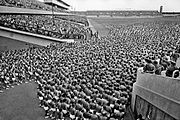You can help expand this article with text translated from the corresponding article in Czech. (March 2024) Click for important translation instructions.
|
| Spartakiad | |
|---|---|
 1965 Spartakiad 1965 Spartakiad | |
| Status | Inactive |
| Genre | Sports event |
| Location(s) | Prague |
| Country | |
| Inaugurated | 1955 (1955) |
| Most recent | 1990 (1990) |
| Sponsor | Communist Party of Czechoslovakia |
The Spartakiads or Spartakiades in Czechoslovakia (Czech and Slovak: Spartakiáda) were mass gymnastics events, designed to celebrate the Red Army's liberation of Czechoslovakia in 1945. The name refers to the 1921 Prague Spartakiad organised by the Communist Party of Czechoslovakia. They were organised by the Communist government as a replacement of the similar Sokol gatherings, which were disapproved by the regime and discontinued after World War II. The Spartakiads took place at the Strahov Stadium, the largest stadium ever built and the venue of the last pre-war Sokol gathering. Most of the organisers of the Spartakiads were former Sokol officials.
History
The first Spartakiad took place in 1955, and was subsequently held every five years. The Spartakiad scheduled for 1970 was canceled in the wake of the Prague Spring and the beginning of normalization. Preparations for the 1990 Spartakiad were interrupted by the Velvet Revolution, but the event still took place as the "Prague Sports Games", albeit on a much smaller scale than the previous ones.
The Spartakiads involved large numbers of people; for example, at the 1960 Spartakiad about 750,000 gymnasts from the whole country took part and over 2,000,000 spectators witnessed the event. The last major edition in 1985 saw around 160,000 people perform across fifteen demonstrations.
Before each Spartakiad, local Spartakiads were held, with juries selecting the best gymnasts from each region for the national event. Men and women of all ages practiced and performed exercise routines. Appearance was originally mandatory for students and servicemen of the armed forces and police. During the Normalization years, it became more voluntary.
The 1985 Spartakiad notably originated the Michal David pop song Poupata (Flower Buds), which remains popular in the Czech Republic today and inspired a 2011 film of the same name.
Gallery
-
1960 Spartakiad view from the stands.
-
 1965 Spartakiad performance.
1965 Spartakiad performance.
-
 Members of the Czechoslovak People's Army about to perform in the 1980 Spartakiad.
Members of the Czechoslovak People's Army about to perform in the 1980 Spartakiad.
-
 1980 Spartakiad view from the stands. The banner on the right reads "For peace, for socialism".
1980 Spartakiad view from the stands. The banner on the right reads "For peace, for socialism".
References
- Bláha, Pavel et al.: Antropometrie československé populace od 6 do 55 let: Československá spartakiáda 1985. = Antropometric studies of the Czechoslovak population from 6 to 55 years: Czechoslovak spartakiade 1985. Praha: Ústřední štáb Československé spartakiády 1985, 1987, 244 p.
- ^ Morkes, František (18 December 2005). "Jak vzniklo slovo "spartakiáda"". Czech Radio (in Czech). Retrieved 18 November 2013.
- ^ Roubal, Petr (30 April 2024). Spartakiads : the politics of physical culture in Communist Czechoslovakia (First English ed.). Czech Republic. ISBN 978-80-246-4366-3. OCLC 1140640610.
{{cite book}}: CS1 maint: location missing publisher (link) - Friedrich, Alex (12 August 1998). "What to do with ab aging giant". Prague Post. Retrieved 18 November 2013.
- "Accommodation in Prague Vokovice – Hostel and Apartments Spartakiáda – About Spartakiada". Hostelspartakiada.cz. Retrieved 18 November 2013.
- Roubal, P. (2020). Spartakiads: The Politics of Physical Culture in Communist Czechoslovakia. Václav Havel Series. Karolinum Press. p. 185. ISBN 978-80-246-3851-5. Retrieved 29 April 2024.
- "The first ever Spartakiad mass exercise and how it was influenced by the Sokol movement". Radio Prague International. 23 June 2020. Retrieved 29 April 2024.
- Marek, Lukáš (21 September 2009). "Strahovský stadion: zašlá sláva spartakiád". Pražský deník (in Czech). Retrieved 29 April 2024.
- ^ T., D. (10 August 1985). "Za socialismus, za mir!". Le Monde.fr (in French). Retrieved 9 April 2024.
- Szantová, Olga (30 June 2000). "Sokol slet starts in Prague". Czech Radio. Retrieved 18 November 2013.
- Chris Johnstone (27 July 2017). "Spartakiady". Radio Prague. Retrieved 14 April 2018.
- "První spartakiáda kombinovala tanky a holuby. Šest totalitních bylo plné prosovětského nadšení s komunistickou symbolikou". Český rozhlas (in Czech). 5 July 2022. Retrieved 9 April 2024.
- "Flower Buds / Poupata". European Film Awards. Retrieved 29 April 2024.